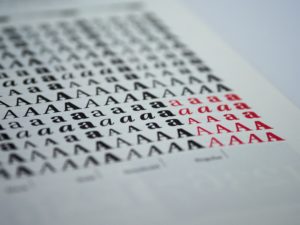
Avid readers of anything content-related, we loved these insights from The Hustle about fonts and typefaces*:
- Netflix switched to its own typeface, Netflix Sans, in 2018. It’s got “cinematic” uppercases and “compact and efficient” lowercases.
- Apple’s Chicago typeface, designed by Susan Kare in 1984 for the 1st Macs, had to be legible on low-res screens.
- Airbnb’s blocky Cereal typeface had to be legible both online and on billboards, and feel “friendly and approachable.”
- Facebook created an all-caps wordmark to differentiate the company from the app, and its lowercase blue wordmark.
- Ebay debuted Market Sans in 2017, plus a flowchart explaining how it’d ensure the new font didn’t slow down browsing.
*And, thanks to The Hustle’s terminology masterclass, we now know that typefaces are the umbrella under which fonts live: Helvetica is a typeface, for example, and Helvetica italics is a font. Good to know!
Whether you’re a company with the budget to create your own typeface or simply making a selection for your brand from the fonts that already exist, there are a couple of things to consider first:
- Tone – does the font convey seriousness or silliness? Twitter aimed to do both with its recently-launched Chirp typeface.
- Legibility – how easy is it to read, especially on mobile? It might be better to limit the use of super-fancy fonts to headers.
Using Experios for your comms? We have great news for you, from a typefaces and fonts perspective. As long as you have permission to use it – and it doesn’t require the installation of any licensing or DRM software – any open font can be used. We’ve recently improved our font uploader function so multiple fonts can be uploaded simultaneously and saved for future projects. You can also control how font size will work on mobile.
We’ll be introducing a permissions control/workflow system to the platform soon, too. This will allow designers to “lock-in” branded templates. Publication editors will be able to update the content – words and images, for example – but won’t be able to alter the publication’s branded look, ensuring content experiences for audiences that are consistently on-brand.







